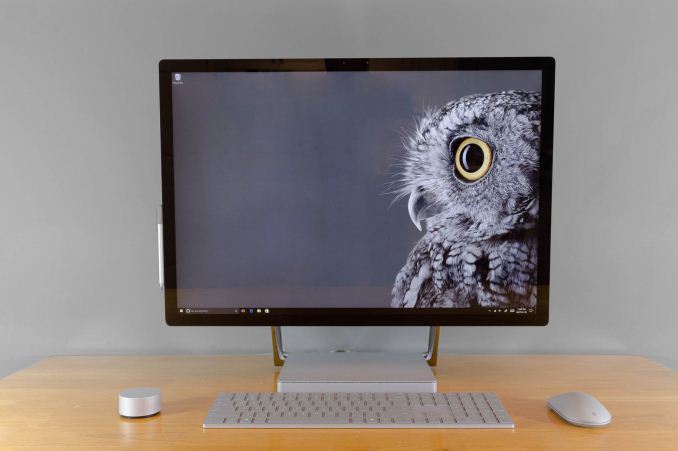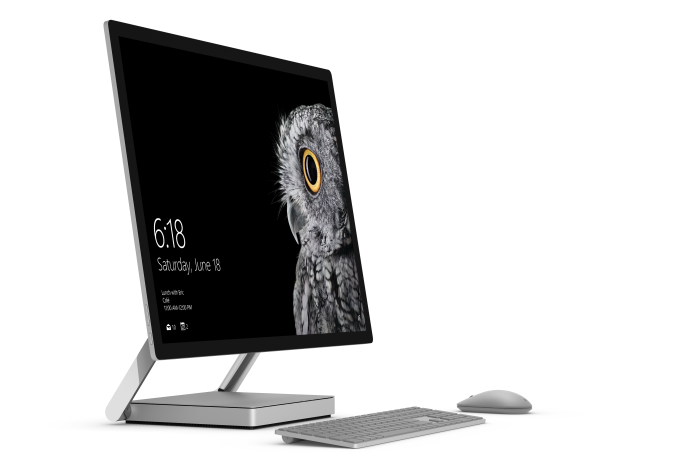The Microsoft Surface Studio Review
by Brett Howse on January 20, 2017 8:00 AM EST- Posted in
- Desktop
- Microsoft
- Surface
- Surface Studio

Microsoft has only been in the PC system game for a few years now, but over the last couple of years they have made a lot of progress rather quickly. These days they have a solid foundation of products available, with the Surface Pro 4 being one of the best convertible tablets, the Surface Book being a very solid convertible laptop, and also the more specialized products like the Hololens, and Surface Hub. Going into their October 2016 event, the one missing piece of their PC product lineup was a desktop computer, but with the announcement and release of the Surface Studio, that particular gap has now been filled.
But the Surface Studio is not your typical desktop PC. Even at first glance, the sleek, beautiful lines are readily apparent, and once powered on, it is rare for anyone to first glimpse the 28.125-inch 4500x3000 display and not say “wow”. It’s not only the very high resolution, but also the 3:2 aspect ratio that is unheard of in this segment, that makes the display stand out as something unique.
Microsoft has become one of the superlative hardware manufacturers in only the short span of four years or so, and the Surface Studio is one of their finest designs yet. However, from the very first Surface RT, Microsoft always tries to add something different, but more importantly interesting, to their designs, and in the case of the Surface Studio, it is the zero-gravity hinge, which allows the all-in-one to be quickly and easily tilted back to a 20° angle, letting it be used as a huge, digital drafting table. Microsoft announced the Surface Studio at their October Windows event, where they also announced the next Windows 10 Update, called the Creator’s Update, and it is wonderful to see them building hardware to truly bring out the exclusive features of their software.
Packed into the base of the Surface Studio is a laptop-class computer, with three different models available now. The base model, coming in at $2999, features an Intel Core i5-6440HQ processor, 8 GB of memory, a 1 TB hybrid drive with a 64 GB SSD cache, and a NVIDIA GeForce GTX 965M GPU. The mid-level model, which costs $3499, bumps the CPU up to an Intel Core i7-6820HQ, doubles the RAM to 16 GB, and doubles the SSD cache to a PCIe 128 GB model, with the same 1 TB HDD and GTX 965M. The highest priced model, at $4199, is an Intel Core i7-6820HQ, 32 GB of RAM, a 2 TB hybrid drive with a 128 GB PCIe cache, and a NVIDIA GTX 980M GPU with 4 GB of memory.
| Microsoft Surface Studio | ||||||
| Base | Middle | Top (As Tested) | ||||
| CPU | Intel Core i5-6440HQ Quad-Core, 2.6-3.5 GHz 6 MB Cache, 45W TDP, No Hyperthreading |
Intel Core i7-6820HQ Quad-Core, 2.7-3.6 GHz 8 MB Cache, 45W TDP, Hyperthreading |
||||
| GPU | NVIDIA GTX 965M 1024 CUDA Cores 944 Mhz + Boost 2 GB GDDR5 128-bit memory |
NVIDIA GTX 980M 1536 CUDA Cores 1038 Mhz + Boost 4 GB GDDR5 256-bit memory |
||||
| RAM | 8 GB DDR4 | 16 GB DDR4 | 32 GB DDR4 | |||
| Storage | 1 TB Hybrid Drive 64 GB SATA SSD Cache / 1 TB SATA HDD |
1 TB Hybrid Drive 128 GB PCIe SSD Cache / 1 TB SATA HDD |
2 TB Hybrid Drive 128 GB PCIe SSD Cache / 2 TB SATA HDD |
|||
| IO | 4 USB 3.0 ports - one high power port Full size SD Card Slot Headset Jack Xbox Wireless Connectivity DisplayPort |
|||||
| Display | 28.125-inch PixelSense Display 4500 x 3000 resolution 192 DPI sRGB, DCI-P3, P3 D65 color modes |
|||||
| Webcam | 5 MP Webcam Windows Hello Facial Recognition |
|||||
| Networking | Marvel AVASTAR 802.11ac Intel I219-LM Gigabit Ethernet |
|||||
| Price | $2,999 | $3,499 | $4,199 | |||
There was quite a bit of discussion at the time of the Surface Studio launch over the fact that it was equipped with older technology. Intel’s Kaby Lake quad-core parts just launched at CES this year, so Skylake quad-core CPUs were the latest generation available at launch. The Maxwell based graphics options chosen were not the latest generation mobile graphics from NVIDIA, with the GTX 965M and GTX 980M available in the Studio. The Pascal based GTX 1060 and GTX 1070 would have been much more powerful substitutes, but they are not pin-compatible drop-in components with the Maxwell GPUs in the Surface Studio, meaning a new board design and thermal considerations would have been necessary late in the design phase, and Microsoft appears to have been conservative here to avoid missing their launch window.
Microsoft has also been very conservative with their I/O choices, with four USB 3.0 Type-A ports on the back of the Studio, along with a SD card slot, and mini DisplayPort. As with the Surface Pro 4 and Surface Book, Microsoft has continued to provide only the older USB-A ports, and not even offer a single USB-C port, let alone with Thunderbolt. Anyone purchasing a Studio will likely be using it for several years, and the lack of USB-C is going to be an issue in the future, if not already today. The Surface team really needs to reconsider this as it is already a detriment to not include any.
There also must be some questions raised about the use of a hybrid drive in a PC of this price. We’ll dig in to the experience later, but Microsoft could and should offer a larger SSD as the boot disk, complimented by a HDD as a secondary disk, at least on the highest end model. A 512 GB NVMe SSD as the boot drive would appease much of the criticism. The computer does cost over $4000 after all, and while much of the cost of the device is in the display, SSDs have been the biggest improvement in user experience on the PC in a long time.











197 Comments
View All Comments
fanofanand - Monday, January 23, 2017 - link
My company employs over 260,000 people, and we just got WIN7 last year. We still have some users on XP. So "it takes a couple years for the enterprise world to catch up" is exactly right. Don't underestimate the need for compatibility with legacy applications in older, larger companies. Besides that, it isn't exactly a small undertaking to swap out the OS (or PCs for that matter) when you are literally dealing with hundreds of thousands of users. The enterprise world is VERY slow to adapt outside of Silicon Valley (or the tech sector in general).BrokenCrayons - Friday, January 20, 2017 - link
The Surface Book's biggest problem is its awful hinge design that doesn't let you fully close the system like pretty much every other clamshell design ever. It leaves that awkward gap to keep the screen from making contact with the keyboard that Microsoft couldn't figure out how to recess deep enough to keep it off the screen were they to give it a more effective hinge. I can't imagine anyone would examine the thing and be impressed by those painfully obvious oversights.Friendly0Fire - Friday, January 20, 2017 - link
Funny, the hinge is actually one of the things I like most about the SB. It means the keyboard isn't recessed and I don't have key markings on my screen every time I open it.It's not because it's different that it's bad, you know?
BrokenCrayons - Friday, January 20, 2017 - link
Key blemishes on a screen are as much of an indication of poor design as the shortcut Microsoft took with the Surface Book's hinge. Either way, you're the victim of thoughtless engineering. Though the biggest problem with the Surface Book hinge isn't really the fact that it underscores the error with keyboard placement, but that it robs the entire system of structural strength when closed. Instead of the whole system accepting pressure and distributing it across the entire chassis, one half or another will be forced to endure those forces alone.There's nothing wrong with finding the appearance appealing. It's simply that in either an attempt to create a visual difference or as compensation for poorly thought out system design, Microsoft selected the hinge to the detriment of its customers. It's not a big deal, really. The Surface Book is an inexpensive little system so there's not much lost if one is damaged. It just seems like thoughtlessness on the part of the company demonstrated in a very visual manner for sketchy justification.
Devo2007 - Friday, January 20, 2017 - link
Surface Book inexpensive? Oh, to have disposable income like that to consider a $2000 laptop inexpensive enough to consider it "not much lost if damaged."BrokenCrayons - Friday, January 20, 2017 - link
Money really isn't the point anyway. No matter what the cost relative to income, people reasonably expect their computers to be designed well and to function without a great deal of trouble. I don't think the Surface series in general has been able to live up to the reputation Microsoft is attempting to give it through its marketing. The SB in particular just doesn't translate well from marketing material to functionality due in part to a variety of problems associated with the hinge (and a few other software/hardware glitches). They have earned a reputation as quirky and unreliable which doesn't help Microsoft land sales.fanofanand - Monday, January 23, 2017 - link
Come back down to earth Mr Crayons, the SB is NOT an inexpensive product. I agree with the rest of your post but you are showing your elitism with a statement like that.BrokenCrayons - Monday, January 23, 2017 - link
I'm sorry! I was really trying to focus on the design and not so much the cost.Manch - Sunday, January 22, 2017 - link
That hinge can handle a lot of stress. Its been proven that durability is not an issue. The purpose of the hinge design was to counter the screen/tablet weight for proper balance when in laptop mode. So what is it exactly that's so poor in its design?BrokenCrayons - Monday, January 23, 2017 - link
You'll see it a couple posts up from the one you replied to.